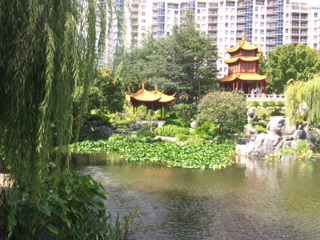 Build in the 1980s as a gift to Sydney from the city of Guangzhou in Southern China, this garden celebrates the relationship between the Chinese community in Australia, as well as the 1988 Bicentential of Australia’s colonial settlement. It covers about 2.5 acres and was designed in the southern style known as Ling-nam, by Chinese landscape architects using the concept of controlling and manipulating natural forms to produce a sense of wildness in a controlled space. The design is governed by the importance of ‘Qi’, the central force of life and energy, as well as by the Taoist principles of Yin-Yang and the five opposite elements: earth, fire, water, metal, and wood.
Build in the 1980s as a gift to Sydney from the city of Guangzhou in Southern China, this garden celebrates the relationship between the Chinese community in Australia, as well as the 1988 Bicentential of Australia’s colonial settlement. It covers about 2.5 acres and was designed in the southern style known as Ling-nam, by Chinese landscape architects using the concept of controlling and manipulating natural forms to produce a sense of wildness in a controlled space. The design is governed by the importance of ‘Qi’, the central force of life and energy, as well as by the Taoist principles of Yin-Yang and the five opposite elements: earth, fire, water, metal, and wood.
As you approach the garden you first encounter the white undulating wall that is reminiscent of a dragon.
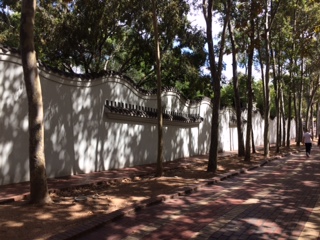
Just before the entrance to the garden you can get a glimpse of water and the Commemorative Pavilion.
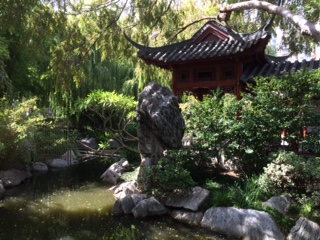
Finally, the entrance greets you with its two its two Foo-dogs, a hybrid of dog,lion,and dragon, that represent loyalty, strength, and prosperity. The female on the left has her cub while the male on the right has a ball of chi (energy).
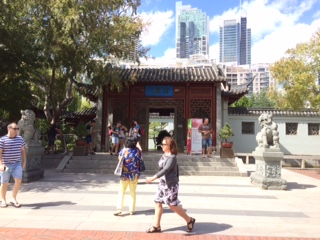
The map of the garden gives a good overview of the many features of the garden including water features, pavilions, and notable plant specimens.
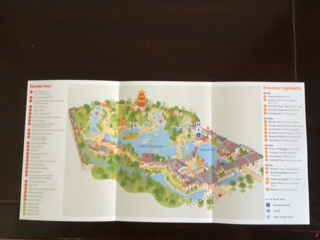
The first area inside the garden is a courtyard that is dominated by large rocks from southern Guangdong.
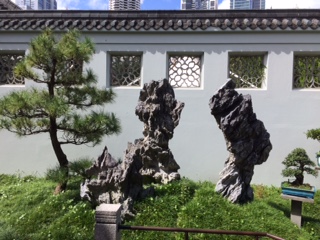
In another area are Penjing, ‘tray scenery’, examples of the Chinese art of creating a miniature landscape. Some examples consist of a single plant, others are more complex.
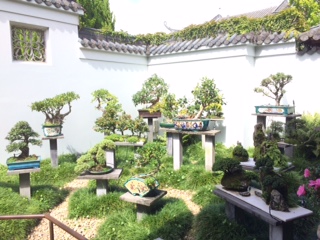
The examples are constantly rotating but include African Lilac Cap, Chinese Banyan Fig, Chinese Elm, Swane’s Golden Cypress, Japanese Honeysuckle, Hollywood Juniper, American Hornbeam, Korean Boxwood and azaleas.
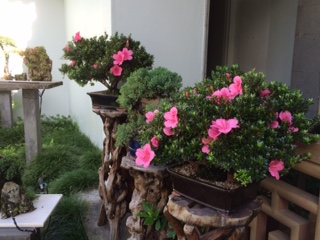
A peek through the leaky window gives you an idea of what is to come.
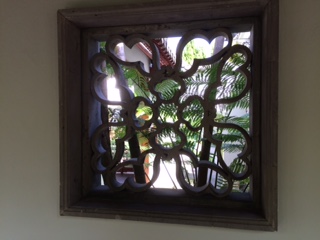
Passing through the Hall of Longevity, you come to the Dragon Wall showing two dragons with the giant Pearl of Prosperity carried on a wave between them. The wall is made of hundreds of glazed pieces. The golden dragon represents the city of Guangdong, the blue the territory of New South Wales, and the pearl the bond of friendship between them.
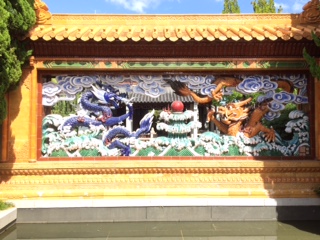
Pavilions allow the visitor to experience the water and (in summer) to enjoy scent of blooming lotuses in the Lake of Brightness.
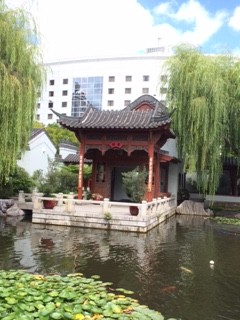
Many varieties of koi swim in the water, adding color and movement to the garden.
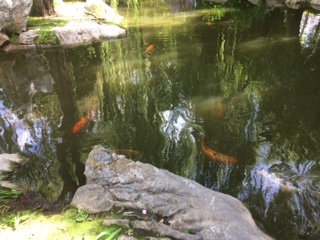
Dragon Rock pushes up into the still water. Common in Chinese gardens, dragons are regarded as kindly guardians and associated with good fortune.
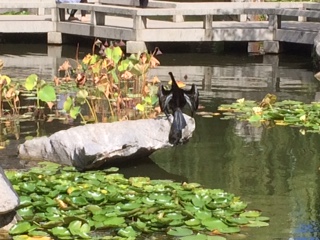
The Round Pavilion sits on high ground with bamboo and rocks all around and provides a good view of the area around it.
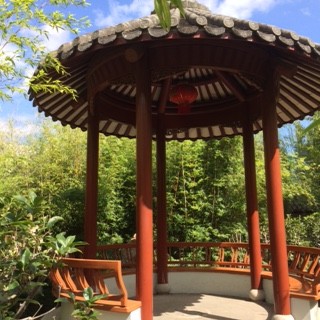
A small courtyard has a moongate.
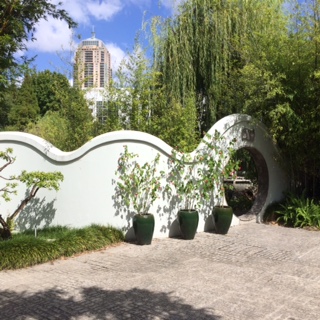
A view through the moon gate gives a glimpse of the lake and waterfall in the distance.
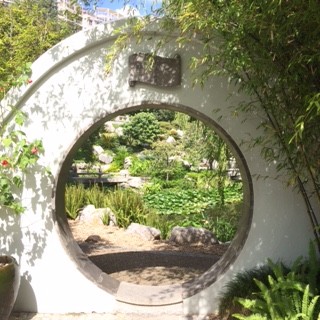
The small simple Reading Book Pavilion provides a place for contemplation and reading while sitting on a traditional bench with a curved backrest.
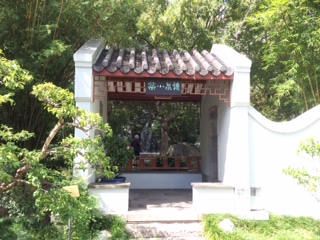
The sound and sight of the waterfall adds to the ambiance.
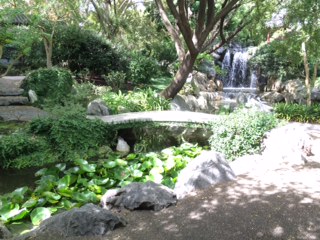
The Wandering Gallery takes the visitor up to the pine-covered mountain.
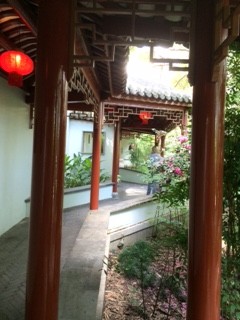
A waterfall starting at the top of the mountain sends water to the Lake of Brightness.
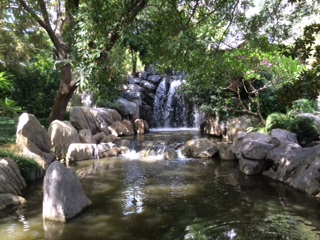
The Rising Jade Pavilion provides a resting place near the top of the mountain with a view of the flowing water. Interestingly, it is more colorful than other pavilions in the garden.
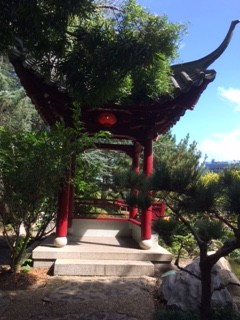
The twin pavilion with its double roof symbolizes the friendship and cooperation between the people of Guangdong and New South Wales. Wood carvings include the waratah, floral emblem of NSW, and the red silk cotton tree, the floral emblem of Guangdong.
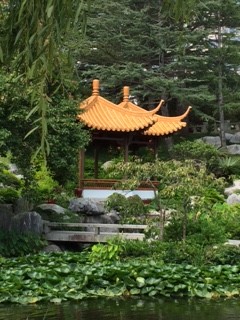
At the peak of the mountain sits the Clear View Pavilion, known as the Gurr. It is a hexagonal building, with a triple tiered roof covered with gold-glazed tiles.
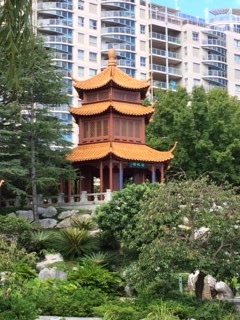
Inside are carved panels showing the three friends of winter (plum, pine, and bamboo), as well as garden flowers such as the lotus.
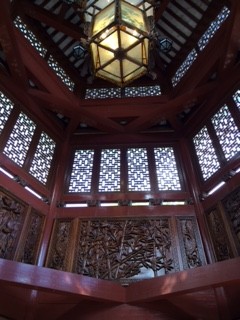
In this panel bamboo is featured.
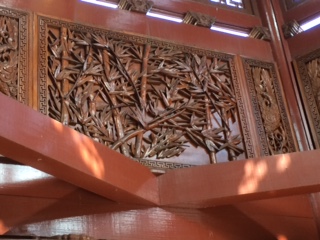
A small simple gate marks the beginning or end of the mountain walk.
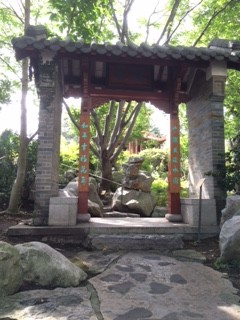
The pavements in the garden are distinctive. In the courtyard this handsome one dominates.
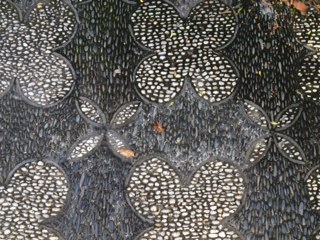
Elsewhere a more geometric pavement prevails.
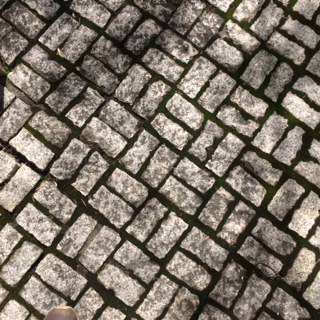
One of the paths combines several design elements.
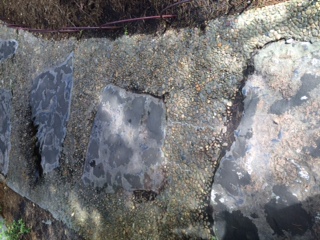
The bridges of the garden add a distinctive Chinese character to the garden.
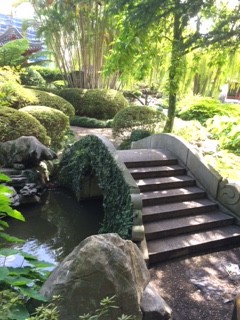
This zig-zag bridge separating the Lake of Brightness from the Lotus Pond discourages ghosts.
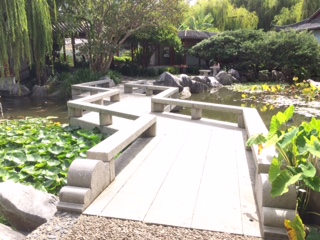
A dragon post with a traditional dragon motif carved around it also features the various animals of the Chinese calendar. It becomes a lantern when a candle is placed in the top section.
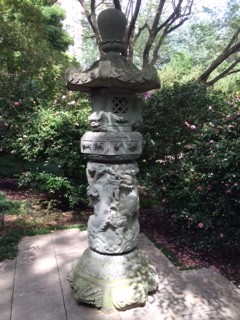
The Sleeping Boy Buddha is adorns a shade spot.
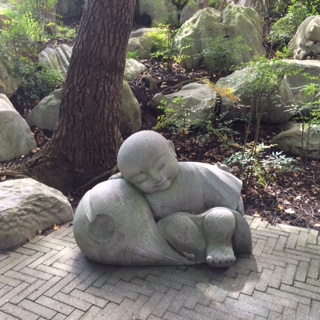
Most of the sculptural elements in the garden are rocks. They play a very important role and are said to bed the bones of a garden. Many of the rocks were chosen and placed on the basis of their shape and resemblance other things like animal, people or places. The rocks are considered to be like something from heaven and bearers of good fortune even if their position seems precarious to the western eye.
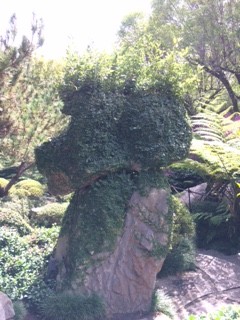
Here rocks that are thought to look like an a horse (or lion) are placed by a pathway to guard against the passage of evil spirits.
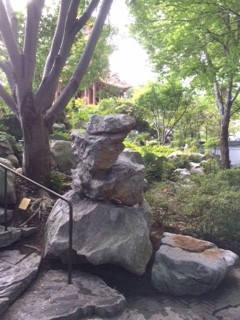
Tall limestone rocks stand for the characters in a traditional fable with a tragic love story that ends with the characters being turned to stone.
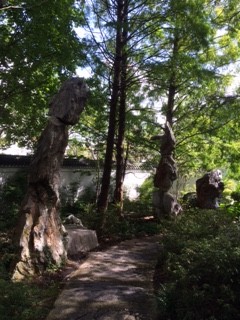
Seven huge rocks in the black bamboo forest represent third-century Chinese scholars and poets as the met to contemplate and formulate the principles of the Taoist philosophy.
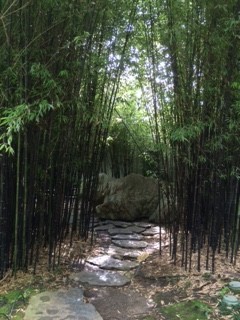
This wax rock, imported from China, is noted for its smooth river-worn texture and rich gold color.
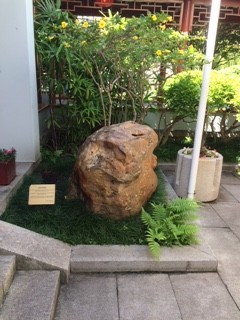
Most of the rocks in this garden are limestone and contain fossils. They were brought from an area near the township of Cumnock, west of Sidney. Large boulders are used along much of the shoreline and along the stream.
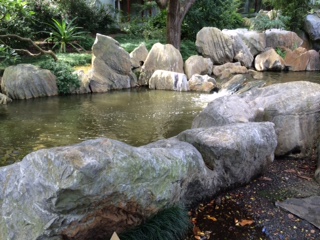
Pebbles are used to soften some of the shoreline.
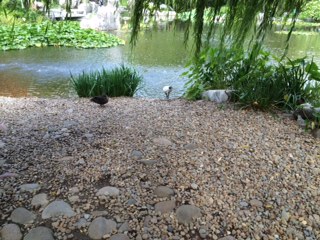
Plants are considered the “flesh” of the garden and have been carefully chosen and placed to provide interest through out the year.
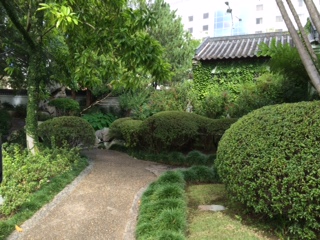
Plum, pine and bamboo are considered to be the three friends of winter. Black pine (Pinus thunbergii) is a traditional tree for a mountain scene and dominates the hill top in the garden.
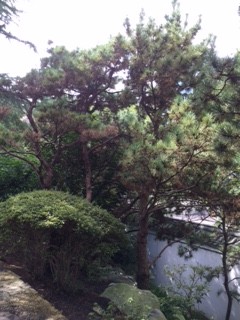
Black bamboo represents a strong and resilient character and is planted along the shore line as well as in the Seven Sages Bamboo Forest and around the Round Pavilion (on right of picture). Its bending and creaking in the wind give life to the garden.
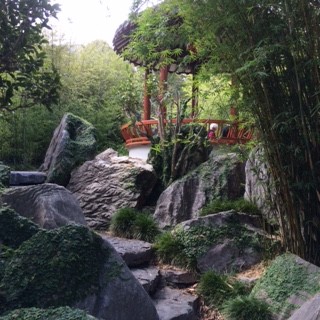
Flowering plum is a symbol of winter and a harbinger of spring because of its very early bloom time. In the arts it stands for perseverance, hope, beauty, purity, and the transitory nature of life.
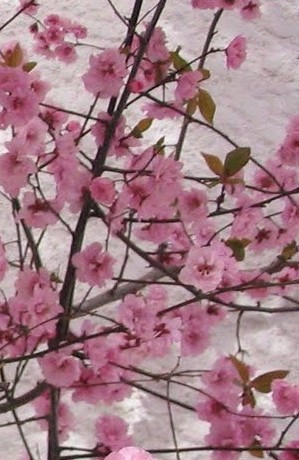
The sacred lotus (Nelumbo nucifera) is loved for the fragrance of its large showy flowers that appear in summer.
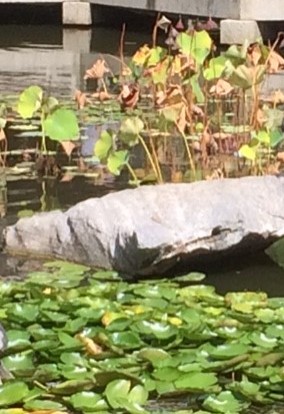
The newly emerging leaves of weeping willow (Salix babylonica) symbolize spring, light, and vitality. The trees are a symbol of feminine grace and often found on the sides of ponds or waterways.
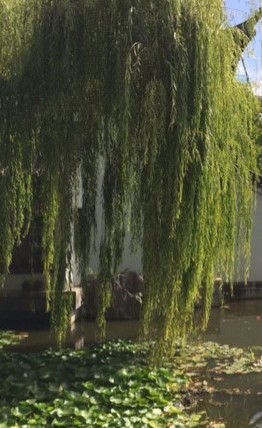
Osmanthus fragrans, the Fujian flower tree, has tiny white flowers beloved for their strong sweet orange blossom scent. Flowering throughout the year, it is frequently used at the entrances of courtyards and building.
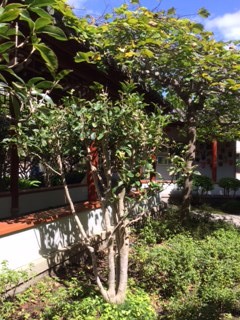
Gardenia augusta ‘Florida’ thrives in the area below the Round Pavilion adding its heady fragrance to the air.
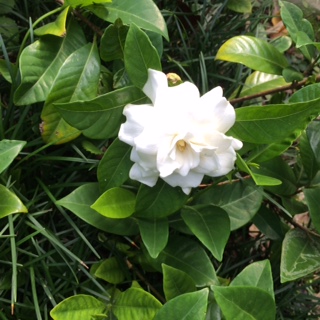
Creeping fig covers a large boulder.
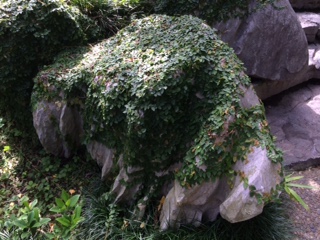
Plants by season of special interest include:
Spring: Chinese peony, Azalea, red silk cotton tree (Bombax ceiba), port wine magnolia (Michelia figo), and pomegranate (Punica granatum).
Summer: Sacred lotus (Nelumbo nucifera), orange jasmine (Murraya paniculata), osmanthus (Osmanthus fragrans), gardenia (Gardenia augusta ‘Florida’), weeping willow (Salix babylonica), frangipani (Plumeria acutifolia)
Autumn: Prince of orange (Ixora chinesis), camellia (Camellia sasanqua), persimmon (Diosppyros kaki), Buddhist pine (Podocarpus elatus).
Winter: Waratah (Telopea speciossissima), Hong Kong rose (Rhodoleia chapionii), flowering apricot (Prunus murme), cherry plum (Prunus cerasifea ‘Nigra’), black pine (Pinus thunbergii)
Wildlife completes the scene:
Birds strut on the pebble shoreline.
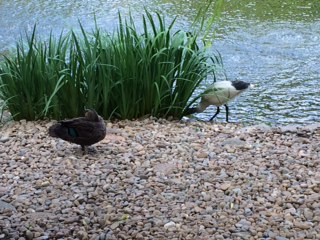
Turtles sun themselves on a rock in the pond.
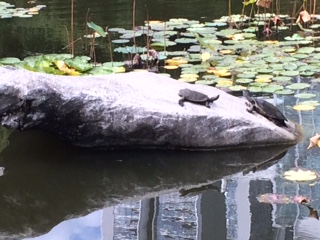
A lizard lies motionless basking basking in the sun.

The garden is a gem! You can reach it from the Circular Quay by going south on Pitt Street right outside the Quay and turning right when you reach Liverpool Street. The garden is on your left when Liverpool Street dead-ends and is easily identified by the dragon wall. This walk takes about 30-40 minutes. We only had an hour to spend in the garden and it was not nearly enough time. If you like gardens, plan on at least two to three hours there. Better yet, stay long enough to have tea at the Tea-house.